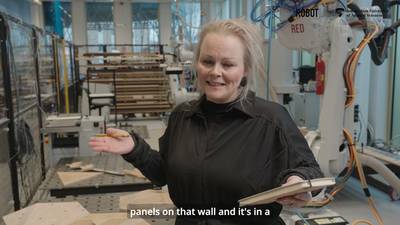Wood is an increasingly demanded renewable resource and an important raw material for construction and materials. Demands are rising, with a growing attention for re-use and upcycling. This opens opportunities for new business models, empowered by the use of digital design and technologies. A KPI-framework has thus been developed to assess the impact of waste wood upcycling, to provide new business perspectives. It is conceived as a tool to enable circular businesses to select the most appropriate circular wood applications for their portfolio. The framework currently consists of eight indicators addressing circularity, environment, society and economics. This paper presents these indicators and shares insights for further development and enhancement of the framework.
MULTIFILE

A summary of requirements for (waste-)wood to be used in CLT, completed with explanation of how to inspect these required properties and recognize wood defects.
DOCUMENT
Since 2016, the Amsterdam Dapperbuurt in the East of Amsterdam, has its own Zero Waste Lab (ZWL), a collection and recycle centre for separated household waste. Drawing on the specific case of wood as a waste-stream, the project Circulair Wood for the Neighbourhood supports the ZWL (initiative of the foundation De Gezonde Stad) realizing two of their ambitions: (A) to transition from recycling to up-cycling; (B) to transition from awareness raising to social engagement and shared ownership. The project is a partnership between the ZWL, the Amsterdam University of Applied Sciences (Research Group Psychology for Sustainable Cities & Research Group Digital Production) and Verdraaid Goed (a Rotterdam based company up-cycling devalued materials by research and design). The project Circulair Wood for the Neighbourhood contains three components/sub-projects, 1) research on the wood waste stream and possibilities for production; (2) research on design possibilities, and (3) research on stakeholder involvement. This is the final report of the sub-project stakeholder involvement led by the research group Psychology for Sustainable Cities. This sub-project specifically examined the psychology behind the decision making process of residents to hand in (or not) separated household wood waste to the ZWL in the neighbourhood of the Dapperbuurt and proposes possible interventions.
DOCUMENT

Growing volumes of wood are being used in construction, interior architecture, and product design, resulting in increasing amounts of wood waste. Using this waste is challenging, because it is too labor-intensive to process large volumes of uneven wood pieces that vary in geometry, quality, and origin. The project “Circular Wood for the Neighborhood” researches how advanced computational design and robotic production approaches can be used to create meaningful applications from waste wood. shifting the perception of circular wood as a simply harvested stream, towards a material with unique aesthetics of its own right. The complexity of the material is suggested to be tackled by switching from the object-oriented design towards designing soft systems. The system developed uses a bottom-up approach where each piece of wood aggregates according to certain parameters and the designed medium is mainly rule-sets and connections. The system is able to produce many options and bring the end-user for a meaningful co-design instead of choosing from the pre-designed options. Material-driven design algorithms were developed, which can be used by designers and end-users to design bespoke products from waste wood. In the first of three case studies, a small furniture item (“coffee table”) was designed from an old door, harvested from a renovation project. For its production, two principle approaches were developed: with or without preprocessing the wood. The principles were tested with an industrial robotic arm and available waste wood. A first prototype was made using the generated aggregation from the system, parametric production processes and robotic fabrication.
DOCUMENT

How can a smart ‘upcycle wood factory’ (powered by industry 4.0 technologies and principles) help create meaningful and viable applications out of residual wood applicable to the hospitality sector?This video gives the answers.
YOUTUBE

Wood is an increasingly demanded renewable resource and an important raw material for construction and interiors and other applications. Yet, 25% of the annually used wood turns into waste, which is mostly incinerated or - in much smaller proportions - turned into particle board. Attention for wood recycling and upcycling is thus growing. Used wood is increasingly being harvested from existing buildings or collected at waste collection sites, and research is being done for processing and re-using this wood waste. One of the most challenging problems related to wood waste re-use is the presence of metal in it. This metal can be functional, expected items, such as hinges in old doors or nails and screws in window frames. But wood can also contain unexpected metal items, such as randomly placed nails, screws and staples in doors applied by building occupants.In this report, different X-ray solutions are presented and compared, in order to evaluate if/how they could be used for metal detection, prior to processing waste wood. These vary from scanning technologies already present on the market for wood industry, to other type of solutions like luggage scanners.
DOCUMENT
Students of the Minor Robotic Production & Circular Materials, collectively built a 6-meter Christmas tree from residual wood donated by Amsterdamse Fijnhout
DOCUMENT
Results of the CW.Code Research Project
DOCUMENT

The video was a compilation of the RAAK-publiek research project 'Circular Wood for the Neighborhood', carried out by the Digital Production Research Group with partners in 2020-2022.
DOCUMENT